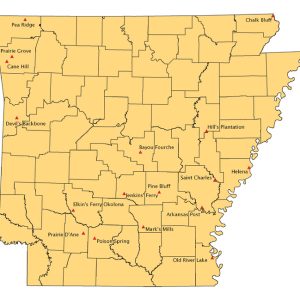calsfoundation@cals.org
Skirmish at Chalk Bluff (May 15, 1862)
| Location: | Clay County |
| Campaign: | Skirmish at Chalk Bluff, Arkansas |
| Date: | May 15, 1862 |
| Principal Commanders: | Colonel Edward Daniels, First Wisconsin Cavalry (US); Lieutenant Colonel William L. Jeffers, Independent Command (CS) |
| Forces Engaged: | Six squadrons of the First Wisconsin Cavalry (US); Independent Command of Lieutenant Colonel William L. Jeffers (CS) |
| Estimated Casualties: | 3 killed and 6 wounded (US); 11 killed and 17 wounded (CS) |
| Result: | Union victory |
On May 15, 1862, Colonel Edward Daniels, commanding elements of the First Wisconsin Cavalry, forced Lieutenant Colonel William L. Jeffers’s independent command from the Chalk Bluff in Clay County, Arkansas, and temporarily restored a Union presence in the area.
Upon hearing rumors of Confederate units in the Missouri Bootheel that could threaten his command at Cape Girardeau, Missouri, Colonel Edward Daniels marched with six squadrons of his First Wisconsin Cavalry to eliminate this threat on May 9, 1862. The next day, he routed the small command of Colonel William J. Phelan ten miles from Bloomfield, Missouri, before turning his column toward a sizable force, rumored at Chalk Bluff, who were alleged to be pressing citizens into service and seizing supplies.
Lieutenant Colonel William L. Jeffers, dubbed the “Captain of the Swamps” by a local newspaper, had been attempting to recruit men for the Confederate defense of the Missouri Bootheel after the merger of the Missouri State Guard into the regular Confederate army earlier in 1862. His independent company, which would eventually become the basis for the Eighth Missouri Cavalry later in 1862, had been harassing local Unionists and attacking small Union forces in the region.
At Chalk Bluff, Jeffers placed his camp in a strong position. The ferry on the St. Francis River at Chalk Bluff allowed individuals moving from the Bootheel of Missouri into northeastern Arkansas to access the elevated roads on Crowley’s Ridge, thus avoiding the swampy roads to the east and west of Crowley’s Ridge. Thus, this location was important in controlling military traffic in the region.
On May 15, 1862, Daniels’s command arrived to find that the Confederates had no guards on the high bluffs on the Arkansas side of the river at Chalk Bluff. Without orders, two privates swam the river and returned the ferryboats back to the Missouri side while under fire. The First Wisconsin Cavalry, fighting dismounted, conducted a difficult river crossing while maintaining suppressing fire. Unable to hold the Wisconsin soldiers back, Jeffers’s command was dispersed into the woods.
The First Wisconsin Cavalry suffered multiple casualties, including two lieutenants wounded, one mortally, and six enlisted men wounded, one mortally. Additionally, one enlisted man was killed outright. The Confederates suffered eleven killed and seventeen wounded. Additionally, the Confederates lost a number of wagons and supplies.
In his report, Daniels noted that a number of people in the region said they had been faking Confederate sympathies to prevent retaliation from Confederate regulars and guerrillas. Announcing that anyone surrendering arms would be treated leniently and those holding them would be considered outlaws, Daniels recounted a large number of people surrendering and requesting Union protection.
Overall, Daniels conducted a successful operation. He routed two Confederate forces, prevented supplies from falling into the hands of the Confederates, and projected a Union force into a region whose inhabitants had been questioning the ability of the Union to protect them. Despite losing men and supplies, Jeffers was still able to recruit more men after this defeat and establish the Eighth Missouri Cavalry in August 1862.
For additional Information:
The War of The Rebellion: A Compilation of the Official Records of the Union and Confederate Armies. Series I, Vol. 13, pp. 64–65. Washington DC: Government Printing Office, 1891.
Derek Allen Clements
Black River Technical College
 Civil War Timeline
Civil War Timeline ACWSC Logo
ACWSC Logo  Civil War Events Map
Civil War Events Map 




Comments
No comments on this entry yet.